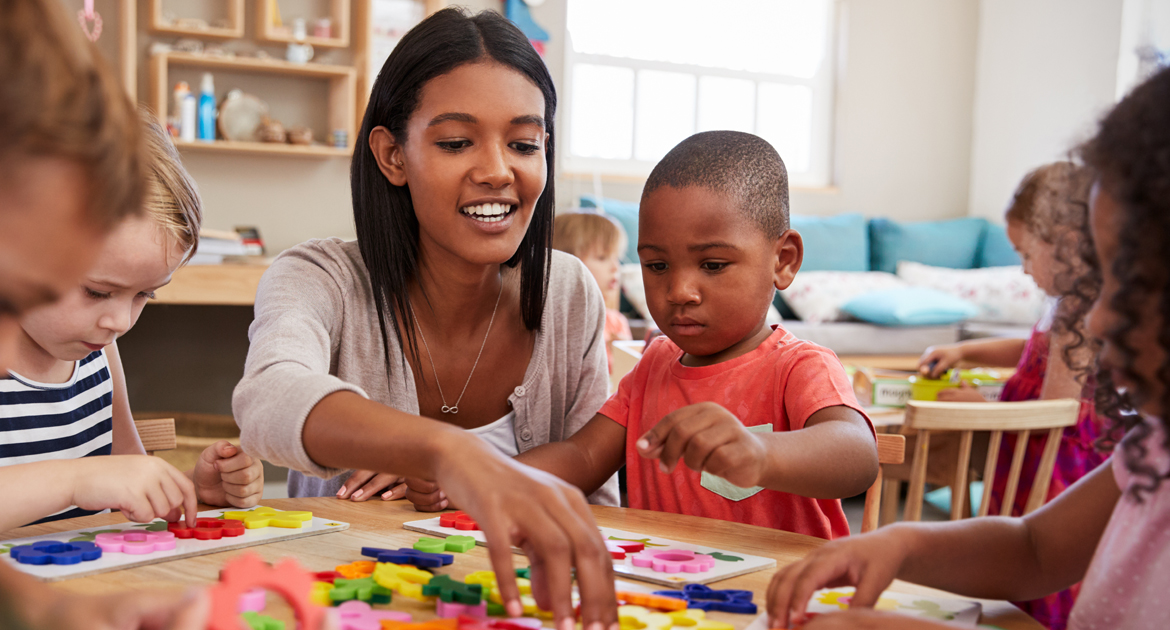TK
TK: English Language Development with Home Language Support
Setting:
Teacher Andrea teaches in a Transitional Kindergarten (TK) classroom in a southern California community which has witnessed a growing multilingual, multicultural population due to recent immigration from Central and South America, as well as from Southeast Asia. Her classroom has always had a few Spanish-speaking children, but now has both Spanish speakers and children who speak Vietnamese at home.
The school in which Andrea teaches has been emphasizing Science, Technology, Engineering, Arts, and Mathematics (STEAM) education for several years and has had good results in the fourth grade state testing. This year, Teacher Andrea has been incorporating more science activities that offer hands-on learning combined with academic vocabulary learning. She has found that the use of interesting materials such as magnifying glasses, ramps, and scales, to explore questions that children pose naturally, reduces the language demand on Multilingual Learner (ML) children and promotes collaboration among peers.
Teacher Behavior:
Teacher Andrea’s TK classroom has been enthusiastically studying how much different objects weigh, and she has introduced several types of scales into her dramatic play and science learning centers. In one lesson, Teacher Andrea organized long paper tubes, short wooden blocks, and plastic animals across the rug. Prior to this lesson, Teacher Andrea labeled all of the objects in English, Spanish, and Vietnamese.
She holds up a wooden block and a paper tube, names them in English, and asks, “Which one do you think is heavier?” She uses gestures to help children understand the word “heavier” by putting her hands out in front of herself and holding one hand lower than the other. On chart paper, she records the number of children who say the wooden block is heavier and the number of children who say the paper tube is heavier.
Teacher Andrea has found that the use of interesting materials such as magnifying glasses, ramps, and scales, to explore questions that children pose naturally, reduces the language demand on Multilingual Learner (ML) children and promotes collaboration among peers.
After recording their answers, Teacher Andrea asks, “How can we find out which is heavier?” She shows a food scale, which only measures ounces. “Would we use this scale?” The children answer quickly, “No.” Then she holds up a scale for measuring body weight and the children again respond, “No.”
Eventually, Teacher Andrea holds up the appropriate scale to measure the items and the children yell out, “Yes!” So, she asks two children to come up and put each item on the scale, and records the number on the scale on the chart paper. She then asks, “Which is heavier?” Anh, who speaks Vietnamese at home, but has been very attentive during all English lessons jumps up and says, “Block.” Teacher Andrea asks Anh to come up and show the class her answer. Anh comes up and points to the number on the chart for “block” and says slowly in English, “Heavy.” The number on the chart under “block” was 28 and the number under “tube” was 8. Anh had understood that the number 28 is larger than 8 and that the block was therefore heavier.
Teacher Andrea asks the class, “Do you agree?” and most call out, “Yes!” Teacher Andrea confirms, “Yes, the block is heavier than the paper tube,” as she points to each object and the numbers on the chart saying, “Twenty-eight is more than eight.”
Teacher Andrea then labels each of the scales in English and tells the children they will be available in the learning centers all week. She encourages them to hold various objects and guess which one is heavier. During the week’s small group time, Teacher Andrea will deliberately group the Vietnamese- and Spanish-speaking children with bilingual children who share their home language and ask them to work together to make charts of their own with the help of her teaching assistant, Miss Anna.
Reflection questions
- Which content learning strategies did Teacher Andrea use in this science lesson? How does each strategy help MLs learn science content, as well as English language vocabulary?
- How else can Teacher Andrea extend this activity to further enhance ML children’s comprehension of the content? Which other strategies can she use to ensure that they are learning the science content, as well as expanding their oral language and vocabulary skills?
- What types of science, math or other content activities have you implemented with your ML children? How do they respond to the lessons and materials? How do/can you support your children in gaining content understanding, as well as oral language and vocabulary skills?


